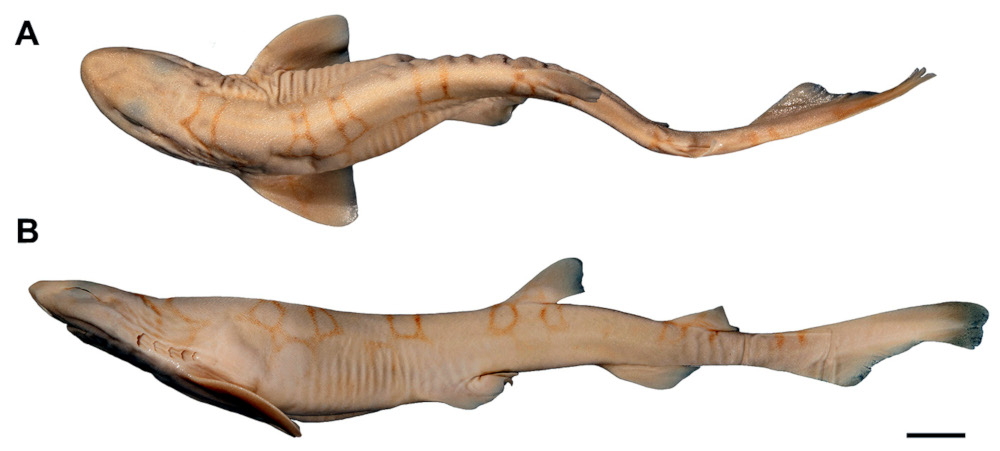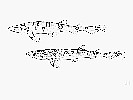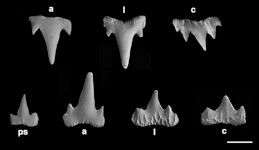Scyliorhinus retifer
(Garman, 1881)
Chain catshark
Classification: Elasmobranchii Carcharhiniformes Scyliorhinidae
Reference of the original description
Reports on the results of dredging, under the Supervisionof 'Alexander Agassiz, along the Atlantic coast of the United States during the summer of 1880, by the U. S. Coast Survey Steamer "Blake," Commander J. R. Bartlett, U. S. N., commanding. XII. Reports on the Selachians. Bulletin of the Museum of Comparative Zoology at Harvard College, 8(11), 231–237
Reports on the results of dredging, under the Supervisionof 'Alexander Agassiz, along the Atlantic coast of the United States during the summer of 1880, by the U. S. Coast Survey Steamer "Blake," Commander J. R. Bartlett, U. S. N., commanding. XII. Reports on the Selachians. Bulletin of the Museum of Comparative Zoology at Harvard College, 8(11), 231–237
Image of the original description
No image in first description.
No image in first description.
Synonyms / new combinations and misspellings
Catulus retifer, Scyliorhinus retifer retifer , Scylliorhinus retifer, Scyllium retiferum
Catulus retifer, Scyliorhinus retifer retifer , Scylliorhinus retifer, Scyllium retiferum
Description :
Citation: Scyliorhinus retifer (Garman, 1881): In: Database of modern sharks, rays and chimaeras, www.shark-references.com, World Wide Web electronic publication, Version 01/2026
Please send your images of "Scyliorhinus retifer" to info@shark-references.com

Scyliorhinus retifer (Garman, 1881), holotype, MCZ 825, male, 311 mm TL (Delaware, United States). A, dorsal view; B, lateral view. Scale bar = 20 mm © Karla A. Soares, Laboratório de Ictiologia, Departamento de Zoologia, Instituto de Biociências, Universidade de São Paulo

Scyliorhinus retifer (Garman, 1881), holotype, MCZ 825, male, 311 mm TL (Delaware, United States). A, dorsal view; B, lateral view. Scale bar = 20 mm © Karla A. Soares, Laboratório de Ictiologia, Departamento de Zoologia, Instituto de Biociências, Universidade de São Paulo
Common names
 Alitán mallero,
Alitán mallero,  Roussette maille,
Roussette maille,  Chain cat shark,
Chain cat shark,  Chain catshark,
Chain catshark,  Chain dogfish
Chain dogfish
 Alitán mallero,
Alitán mallero,  Roussette maille,
Roussette maille,  Chain cat shark,
Chain cat shark,  Chain catshark,
Chain catshark,  Chain dogfish
Chain dogfish
Short Description
Diagnosis after Compagno, 1984 [517]: Field Marks: The bold chain colour pattern of black lines is unique to this shark and Cephaloscyllium fasciatum; but the latter species has no labial furrows and more anteriorly situated dorsal fins. Diagnostic Features: Head and body relatively deep, slender and narrow; greatest width of head about 2/3 of head length; no nasoral grooves; anterior nasal flaps not expanded and falling somewhat anterior to mouth. First dorsal origin somewhat behind pelvic insertions; second dorsal origin somewhat anterior to anal insertion; interdorsal space considerably greater than anal base. Denticles small and flat, surface of skin relatively smooth. Colour pattern of bold black lines, outlining obscure dusky saddles and sometimes extending over lateral surfaces and back as a reticular network; no light or dark spots. Size moderate, adults below 50 cm.
Diagnosis after Compagno, 1984 [517]: Field Marks: The bold chain colour pattern of black lines is unique to this shark and Cephaloscyllium fasciatum; but the latter species has no labial furrows and more anteriorly situated dorsal fins. Diagnostic Features: Head and body relatively deep, slender and narrow; greatest width of head about 2/3 of head length; no nasoral grooves; anterior nasal flaps not expanded and falling somewhat anterior to mouth. First dorsal origin somewhat behind pelvic insertions; second dorsal origin somewhat anterior to anal insertion; interdorsal space considerably greater than anal base. Denticles small and flat, surface of skin relatively smooth. Colour pattern of bold black lines, outlining obscure dusky saddles and sometimes extending over lateral surfaces and back as a reticular network; no light or dark spots. Size moderate, adults below 50 cm.
Distribution
Gulf of Mexico, from off Campeche, Mexico (95ºW) to Florida (83ºW), to the northeast coast of United States, from Georgia (30ºN) to Connecticut (41ºN) [27296] Source: www.gbif.org
Gulf of Mexico, from off Campeche, Mexico (95ºW) to Florida (83ºW), to the northeast coast of United States, from Georgia (30ºN) to Connecticut (41ºN) [27296] Source: www.gbif.org
Human uses
fisheries: of no interest
fisheries: of no interest
Biology
Oviparous, paired eggs are laid. Embryos feed solely on yolk [733]. During courtship and prior to copulation, the male bites and wraps female pectoral fin body, tail and gills (Ref. 49562, 51128).
Oviparous, paired eggs are laid. Embryos feed solely on yolk [733]. During courtship and prior to copulation, the male bites and wraps female pectoral fin body, tail and gills (Ref. 49562, 51128).
Dentition
Monognathic heterodonty gradual well developed; anterior teeth abruptly larger than the parasymphysial ones and lateral teeth smaller distally, with smaller and thicker principal cusps (Fig. 66). Sexual heterodonty well pronounced, with females presenting anterior teeth with lower principal cusp and well-developed cusplets in relation to males. Tooth counts 18–26 18–28/17–25 1 16–24 (20–21/19–1–20). Parasymphysial teeth with a principal cusp flanked by one cusplet on each side; cusplets half the height and the width of the principal cusp. Protuberances on medial portion of the crown base and striae restricted to the crown base. Anterior teeth larger than the parasymphysial and principal cusp less stout. Anterior teeth with four cusplets; marginal cusplets corresponding to half the height of proximal cusplets in males and 2/3 in females. Proximal cusplets corresponding to less than half the height and the width of the principal cusp in both sexes. Protuberances on the crown base; striae restricted to the crown base in males and extending through more than half the height of the principal cusp in females. Lateral teeth with four cusplets; marginal cusplets 2/3 the height of proximal cusplets. Protuberances on the crown base; striae more prominent and running from base toward the apex of principal cusp in females, and poorly developed and reduced in males. Commissural teeth with two cusplets; principal cusp stronger and laterally situated. Cusplets corresponding to 2/3 the width and the height of the principal cusp. Protuberances present and striae extending to half the height of the principal cusp. Ectodermal pits present in lateral and commissural teeth, restricted to the crown base. [27296]
Monognathic heterodonty gradual well developed; anterior teeth abruptly larger than the parasymphysial ones and lateral teeth smaller distally, with smaller and thicker principal cusps (Fig. 66). Sexual heterodonty well pronounced, with females presenting anterior teeth with lower principal cusp and well-developed cusplets in relation to males. Tooth counts 18–26 18–28/17–25 1 16–24 (20–21/19–1–20). Parasymphysial teeth with a principal cusp flanked by one cusplet on each side; cusplets half the height and the width of the principal cusp. Protuberances on medial portion of the crown base and striae restricted to the crown base. Anterior teeth larger than the parasymphysial and principal cusp less stout. Anterior teeth with four cusplets; marginal cusplets corresponding to half the height of proximal cusplets in males and 2/3 in females. Proximal cusplets corresponding to less than half the height and the width of the principal cusp in both sexes. Protuberances on the crown base; striae restricted to the crown base in males and extending through more than half the height of the principal cusp in females. Lateral teeth with four cusplets; marginal cusplets 2/3 the height of proximal cusplets. Protuberances on the crown base; striae more prominent and running from base toward the apex of principal cusp in females, and poorly developed and reduced in males. Commissural teeth with two cusplets; principal cusp stronger and laterally situated. Cusplets corresponding to 2/3 the width and the height of the principal cusp. Protuberances present and striae extending to half the height of the principal cusp. Ectodermal pits present in lateral and commissural teeth, restricted to the crown base. [27296]
Remarks
shark-references Species-ID=6345;
shark-references Species-ID=6345;



















